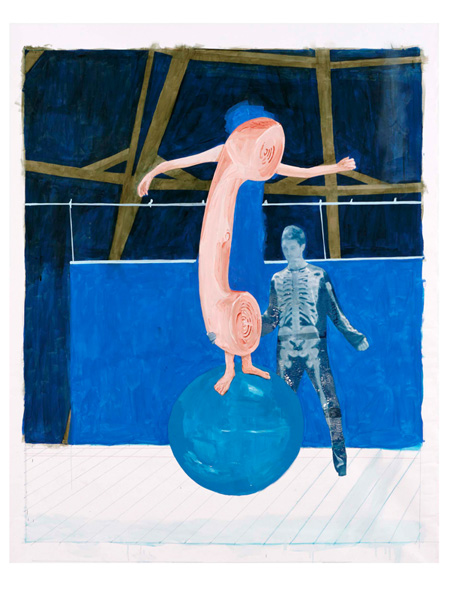
Avant Spectacle A Micro Medicine Show, from 2011, features skeleton-costumed performers inexpertly singing and playing instruments while six knee-high wooden letters – S, P, E, E, C and H – burn like small condemned buildings at front of stage.
As one art critic has pointed out, Lowe and Riva ‘work together, but not simply as individuals, nor simply as a couple, nor simply as collaborators. They are peripatetic, constantly on the move from Melbourne to New York to Turin to Paris to Bordeaux to Singapore, and their work often takes transformations of movement as its object.’ The movements of A Constructed World, then, might be said to trace the wanderings of collaboration itself. In assembling the poetic collaborations gathered here, I was frequently reminded of this sense in which ‘the genus is always one of its own species’.1 As Louis Armand and John Kinsella point out in the notes to their Synopticon, there is a sense in which ‘all writing, all forms of cultural “production,” imply collaboration.’2 For Armand and Kinsella, however, it is through the deliberate activation of this mode that ‘collaboration steps beyond the implied to the overtly political.’ In his brilliantly aleatory introduction to Synopticon, the poet and translator, Pierre Joris, argues that ‘language itself is always already a translation’3 and so, whether produced solo, in tandem, or through the auspices of a group, to ‘make words with things’ is to open the valves, to countenance the existence of what we might think of as something like a ‘principal of contamination’, to enact the repeated staging of the frisson that can frequently seem to be altogether missing from daily life yet is arguably constitutive of it.
Contents
Michael Farrell and Oscar Schwartz: Th E Ma N Fr Om Sn Ow Ri Ver
Amaranth Borsuk and Brad Bouse: Between Page and Screen (Cordite remix)
Toby Fitch and Kate Middleton: Alchemical
Pam Brown: with Maged Zaher, with John Kinsella and for Kate Fagan
Justin Clemens: A Disjoint, Truncated Tale …
Charles Bernstein and Richard Tuttle: Variations in Catullus 85
Jessica Wilkinson and Simon Charles: Arrangement of Manteia y marionette
Timothy Yu: Three Chinese Silences
Ken Bolton and John Jenkins: Manic at Night
Marty Hiatt and Sam Langer: Three Poems
Patrick Jones: Two Poems
Astrid Lorange and Eddie Hopely: excerpt from Hot Pocket
Nick Whittock and Tim Wright: Two Drome Videos
Arising out of this fissure at the heart of language, we find a previously unpublished extract from Amaranth Borsuk’s Between Page and Screen, a ‘kind of digital pop-up book’ of poems that relies on the reader’s ability to hook up to a webcam and trigger the software that decodes a series of stencilled markers. These stand in for a compendium of letters exchanged between two boundary-challenged lovers, P and S. Borsuk’s ouevre is frequently regulated by an ethics of constraint (see her recent Handiwork which investigates ‘the relationship between writing and torture’). This technological collaboration with web architect, Brad Bouse, hobbles itself to technology and the reader in a projection that situates the encoded materiality of the book at the site of its own distortion and reminds us of the holographic status of the object.
Toby Fitch and Kate Middleton have previously demonstrated individual fascinations with the treacherous and rewarding interactions that take place when language goes after image, Fitch in his use of the notorious Rorschach inkblot tests as triggers for an attempted reconfiguration of the Orpheus myth (Rawshock 2012) and Middleton through numerous poems and essays that investigate the ekphrastic. Any way you want to look at it, the relationship between image and text is always going to be one that tarries with ‘that which cannot be crossed’.4
Their ‘Alchemical’ takes the form of a sestina that makes a move on Brett Whiteley’s epic 18-panel painting, Alchemy. The poem comes across as a wild mistranslation of its own intentions, pinned in place by the formal constraints of the sestina and alerting this reader at least to a situation in which form can be said to posit impossibility itself: ‘You’re especially wild / With a strange malaise for more’.
- Slavoj Zizek. The Metastases of Enjoyment: On Women and Causality. London: Verso, 2005. 97. ↩
- Louis Armand and John Kinsella. Synopticon. Prague: Litteraria Pragensia Books, 2012. 7. ↩
- Louis Armand and John Kinsella. Synopticon. Prague: Litteraria Pragensia Books, 2012. 11. ↩
- Jacques Lacan, The Ethics of Psychoanalysis, London: Routledge, 1992, p. 151. Cited in Slavoj Zizek, ‘Courtly Love, or, Woman as Thing’ in The Metastases of Enjoyment: On Women and Causality. London: Verso, 2005. 91. ↩









